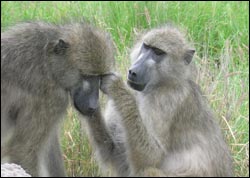Baboons in Mourning Seek Comfort Among Friends

Sylvia grooms Sierra’s cheek
When Sylvia the baboon lost Sierra, her closest grooming partner and daughter, to a lion, she responded in a way that would be considered very human-like: she looked to friends for support. According to researchers from the University of Pennsylvania, baboons physiologically respond to bereavement in ways similar to humans, with an increase in stress hormones called glucocorticoids. Baboons can lower their glucocorticoid levels through friendly social contact, expanding their social network after the loss of specific close companions.
“At the time of Sierra’s death, we considered Sylvia to be the queen of mean. She is a very high-ranking, 23 year-old monkey who was, at best, disdainful of females other than Sierra,” said Anne Engh, a postdoctoral researcher in Penn’s Department of Biology. “With Sierra gone, Sylvia experienced what could only really be described as depression, corresponding with an increase in her glucocorticoid levels.”
Engh works with Penn biologist Dorothy Cheney and Robert Seyfarth, a professor in Penn’s Department of Psychology. For the last 14 years, Cheney and Seyfarth have followed a troop of more than 80 free-ranging baboons in the Okavango Delta of Botswana. Their research explores the mechanisms that might be the basis of primate social relationships and how such relationships may have influenced the development of human social relationships, intelligence and language.
To study the response of stress among baboons, Engh and her colleagues examined the glucocorticoid levels and grooming behavior of females in the troop to see how closely they resemble patterns seen in humans. Their findings were published in a recent article in the Proceedings of the Royal Society of Biological Sciences.
Grooming, a friendly behavior where baboons clean each other’s fur, is the primary means by which baboons strengthen social bonds. According to Engh, while the death of a close family member was clearly stressful over the short term, the females they studied appeared to compensate for this loss by broadening and strengthening their grooming networks. As they resumed grooming, their glucocorticoid levels returned to normal.
” Without Sierra, Sylvia really had nobody else,” Engh said. “So great was her need for social bonding that Sylvia began grooming with a female of a much lower status, behavior that would otherwise be beneath her.”
Through her study, Engh was able to track patterns in stress of the female baboons over time through their glucocorticoid levels. Their stress levels increased most often during events when their lives, the lives of their offspring and their social rankings were at risk. The leading cause of death among adult baboons is predation, usually from leopards and lions. The stress levels of female baboons increased most noticeably when a predator killed a close companion, such as a grooming partner or offspring. If they merely witness another baboon die they do not become as agitated.
“Our findings do not necessarily suggest that baboons experience grief like humans do, but they do offer evidence of the importance of social bonds amongst baboons,” Engh said. “Like humans, baboons seem to rely on friendly relationships to help them cope with stressful situations.”
Engh’s research was funded by grants from the National Institutes of Health. Co-authors on the paper include Jacinta Beehner, Thore Bergman, Dorothy Cheney and Robert Seyfarth from Penn; Patricia Whitten from Emory University; and Rebekah Hoffmeier of the Moremi Baboon Project in Botswana.
Media Contact
More Information:
http://www.upenn.eduAll latest news from the category: Life Sciences and Chemistry
Articles and reports from the Life Sciences and chemistry area deal with applied and basic research into modern biology, chemistry and human medicine.
Valuable information can be found on a range of life sciences fields including bacteriology, biochemistry, bionics, bioinformatics, biophysics, biotechnology, genetics, geobotany, human biology, marine biology, microbiology, molecular biology, cellular biology, zoology, bioinorganic chemistry, microchemistry and environmental chemistry.
Newest articles

“Nanostitches” enable lighter and tougher composite materials
In research that may lead to next-generation airplanes and spacecraft, MIT engineers used carbon nanotubes to prevent cracking in multilayered composites. To save on fuel and reduce aircraft emissions, engineers…

Trash to treasure
Researchers turn metal waste into catalyst for hydrogen. Scientists have found a way to transform metal waste into a highly efficient catalyst to make hydrogen from water, a discovery that…

Real-time detection of infectious disease viruses
… by searching for molecular fingerprinting. A research team consisting of Professor Kyoung-Duck Park and Taeyoung Moon and Huitae Joo, PhD candidates, from the Department of Physics at Pohang University…





















